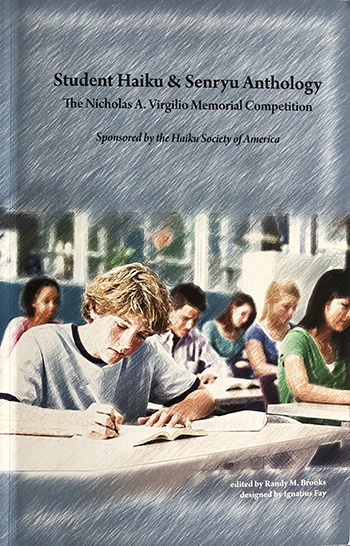Haiku Society of America Student Haiku Awards
in Memorial of Nicholas A. Virgilio
~ ~ ~
Student Haiku Awards for 1992
Carol Purington and Kathleen R. O’Toole
judges
In this third year of the contest conducted in memory of Nicholas A. Virgilio, the number of entries again increased significantly. Well over 500 haiku were sent in by students from 15 schools in 9 states in the USA (Iowa, Missouri, New Jersey, New Mexico, New York, North Carolina, Pennsylvania, Texas, Wisconsin) and students in Mexico and Romania.
The level of technical maturity displayed by these young writers is impressive. Precise, vivid images, handled with economy and objectivity, present subjects ranging from dull lectures to drunken fathers, from babies to sunsets to AIDS to Christmas trees. One-, two-, and four-line formats are experimented with, as are minimalist and visual techniques.
The seven winning haiku, chosen from dozens of fine poems, honor the standard of excellence set by the late Nick Virgilio. Our congratulations to writers and teachers! We extend our thanks to Raffael de Gruttola, 1992 HSA President, for giving us this challenging opportunity, and to Minna Lerman, 1992 HSA Vice-President and Contest Coordinator, for her indispensable help. ~ Carol Purington and Kathleen R. O’Toole
indian chant
only white men
dancingChris McQuillen
Wahlert High School, Age 14, grade 9, Dubuque, IAAuditory and visual images are skillfully blended in this haiku. We clap to the voices, we sway with the bodies. And in one way, singers and dancers are in rhythm: the strong beat of the voices is felt and followed by the moving feet. Yet we perceive, as well, the broken rhythm of a tourist's world in which Native Americans do not dance to their own music and white men dance to words they do not understand.
silent study hall:
my stomach growls
anywayCindy Stierman
Wahlert High School, Age 17, grade 12, Dubuque, IASometimes, even when you want to go along with the rule-makers, the body just won't cooperate. Sound effects and timing are wonderful here—the hush imposed by those three initial "s's," the onomatopoeic explosion of "growl," then the hesitation of that telling third line.
After his funeral,
the white line
on her tanned finger.David Sickler
Wyoming Valley West High School, Age 16, grade 11, Plymouth, PAThis subject almost defies the restraint required in haiku. The writer succeeds by use of the austere contrast between white skin and tanned finger. That pale band somehow conveys the emotional blankness that follows the funeral of someone who shouldn't have left us.
I and the dog
hunting together
the evening mosquitoes.Olivia Diana Bangal
Secondary School, Age 14 , Constanta, RomaniaAn end-of-the day outing with a good companion turns into an encounter with other predators. The unexpected reversal of roles, along with the relaxed tone and flow of images, distinguish this light-hearted piece.
out of sight o
ballo n
and the child’s smileBen Meier
Wahlert High School, Age 15, grade 9 , Dubuque, IAOh, we say, when we see an escaped balloon, and that is literally what the reader of this visual haiku says. This admirable poem employs a balloon to show us the loss of something as evanescent as balloons—a child's joy.
Inside its shell
a snail
and rain . . .Yezmin Soberanes Albert
Hamilton School, Age 17, grade 11, Mexico D.F., MexicoWith a handful of words the poet gives us not only the snail's world of shell and rain, but also that place in our own particular world where snails shine—your wet sidewalk, my damp garden path. The slant rhyme of "shell" and "snail" and the assonance of "snail" and "rain" further compact the scene.
butterflies in the air
in the herbarium
deep silenceDiana Stanciu, Constanta, Romania
The serenity of this haiku draws the reader away to a brief rest in a beautiful spot. One's eyes follow the swirlings of colorful butterflies, and for a few moments there is no noise, no rush, no tension.
~ ~ ~
